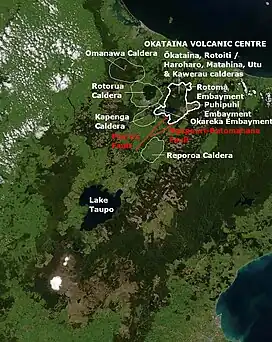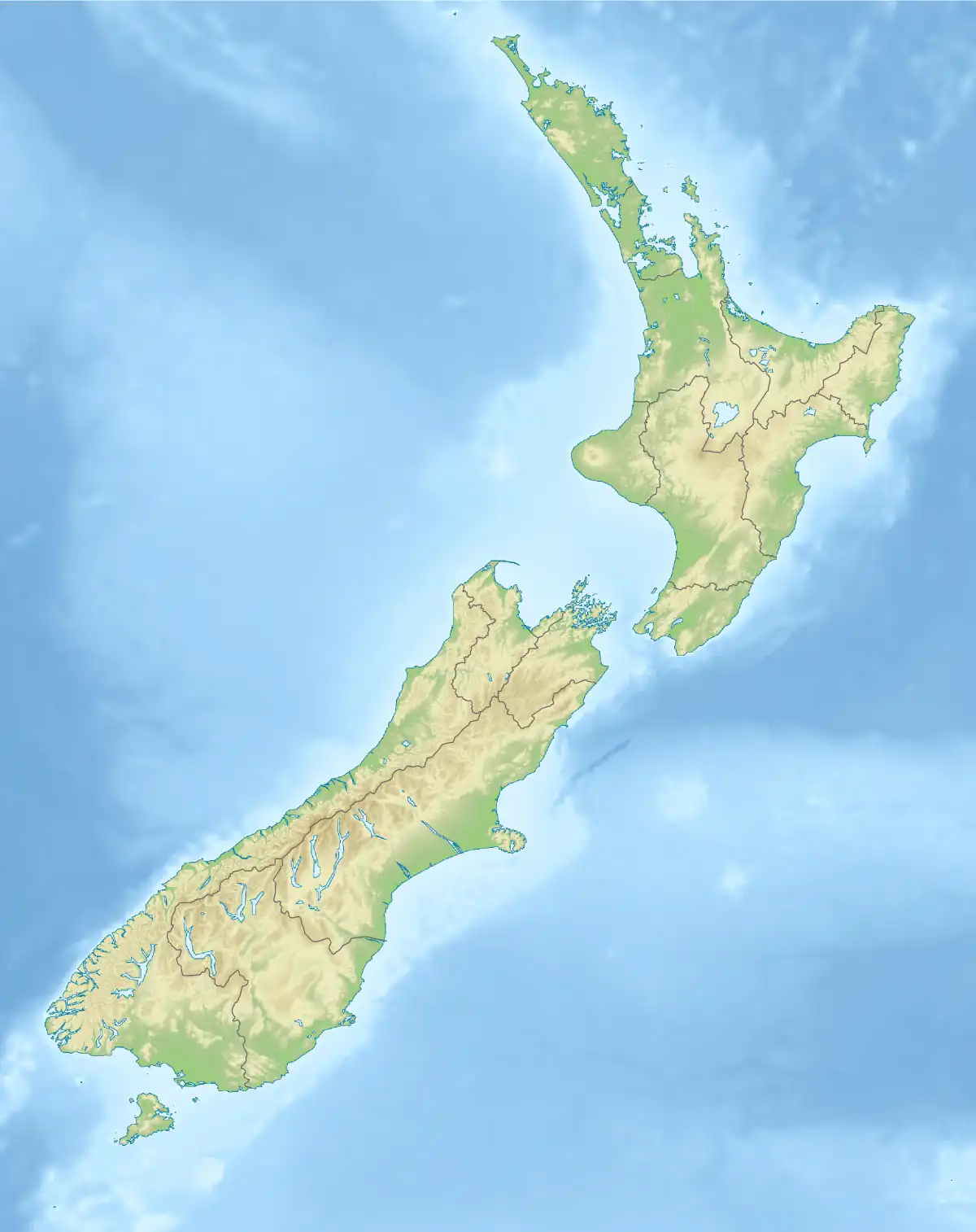| Kapenga Caldera | |
|---|---|
| Kapenda Volcanic Centre | |
 The Kapenga Caldera is to the south of the Rotorua Caldera and to the south-east of the Ōkataina Caldera (thick white border). Relationships to other nearby volcanic and tectonic structures is also shown. | |
| Highest point | |
| Coordinates | 38°16′S 176°16′E / 38.27°S 176.27°E |
| Geography | |
 Kapenga Caldera  Kapenga Caldera Kapenga Caldera (North Island) | |
| Country | New Zealand |
| Region | Waikato |
| Geology | |
| Age of rock | approximately 890,000 years |
| Mountain type | Caldera |
| Volcanic region | 275,000 ± 10,000 years ago[1] |
| Climbing | |
| Access | State Highway 5 (New Zealand) |
The Kapenga Caldera (also known as the Kapenda Volcanic Centre) in New Zealand’s Taupō Volcanic Zone lies in a low land area immediately south of Lake Rotorua through the Hemo Gap in the Rotorua Caldera rim. At some time more than 60,000 years ago Lake Rotorua drained through the Hemo Gap and some of the Kapenga Caldera floor was likely occupied by a lake, that has been called Kapenga.[2]: 360
Geography

The Kapenga Caldera has a western boundary defined by the Horohoro cliffs and an eastern boundary by volcanic domes, including those in the Ōkareka Embayment with some buried by the younger activity of the Ōkataina Volcanic Centre. Its southern boundary of volcanic activity is ill defined but does not extend to areas of continuing low residual gravity abnormality in the Paeroa Garben.
Geology
The Kapenda Caldera, just south of the Rotorua Caldera and between this and the Maroa Caldera, is believed to have been buried by subsequent eruptions including those of the Tarawera volcanic complex. The eastern area of the postulated caldera has had, relative to much of the rest of the central Taupō Volcanic Zone, many smaller eruptions after caldera formation.[3] Problematically to date no definite assignment of the up to seven ignimbrites attributed to it can be related to a definite caldera-forming event or documented collapse despite geology suggestive that such may have occurred.[4] It had several very large eruptive events during the ignimbrite flare-up of the Taupō Volcanic Zone between 350,000 to 240,000 years ago.[1] The boundary between the Kapenda Caldera and the Ōkataina Caldera is debated which particularly affects more recent Earthquake Flat activity. The Kapenda Caldera occupies the northern part of the Paeroa Garben between the uplift caused by the now fairly inactive Horohoro Fault and the uplift associated with the still very active Paeroa Fault. To the south of the caldera is the Ngakuru Graben. For an unknown period between the Mamaku Ignimbrite eruption of the Rotorua of 240,000 years ago and about 60,000 years ago Lake Rotorua drained via the Hemo Gorge into the Kapenga Caldera which likely contained a lake, and through the Ngakuru Graben, onwards to the Waikato River as it existed then.[2]: 358–360 Subsequent volcanic activity has buried much evidence of this phase of the caldera's history.
A large number of intra-rift faults called the Taupo Fault Belt and associated with the modern Taupō Rift exist in the Paeroa Garben and Kapenga Caldera so it is quite a tectonically active area presently.
The paired in time Rotoiti eruption and Earthquake Flat Breccia eruptions, had the later assigned to the Kapenga Caldera as it was within the old caldera's margins, but with greater understanding is assigned to the magma mush body that underlays the magma bodies of the Ōkataina Volcanic Centre and thus to this volcanic centre.
There are two rhyolite domes of note. These are the Horohoro Cliffs at 817 m (2,680 ft), a rim-fracture dome associated with the Horohoro Fault that marks the northwestern edge of the Kapenda Caldera, and Haparangi a late-stage intra-caldera dome that rises above the Ngakuru Graben to 688 m (2,257 ft).[5] Haparangi Rhyolite has been a term used since 1937 to any rhyolite flows/lavas of Pliocene-Pleistocene origin in the Taupo Volcanic Zone and does not imply any origin from the Kapenda Caldera.[5]
The northern part of the caldera has amongst the highest rate of subsidence in the Taupō Rift.[6]: 4672 This is believed to be predominantly driven by cooling and subsequent contraction of an underlying magma body at about 6 km (3.7 mi) depth.[6]: 4667, 4677
Eruptions
Its known eruptions were:
- 890,000 - 680,000 years ago
- 310,000 - 275,000 years ago
- The caldera is not a source of some of the Mamaku ignimbrite as previously speculated - this all originates from Rotorua Caldera.[8]
- Neither is the caldera the source of the Ohakuri Ignimbrite as previously speculated.[5] This comes from the Ohakuri Caldera[9]
- Pokai ignimbrite (0.275 ± 0.01 Ma)[1] (previously assigned 0.23 - 0.22 Ma)[5]
- Waihou (Chimp, Chimpanzee) Ignimbrite (0.31 ± 0.1 on stratographic grounds)[1] (previously assigned 0.26 - 0.25 Ma) [5]
- (felt misassigned)[5] 47,400 ± 1500 years ago (Earthquake Flat Breccia)[10]
References
- 1 2 3 4 5 6 7 8 9 10 11 Kidd, Maia Josephine (2021). Landscape Evolution in Ignimbrite Terrain: a study of the Mamaku Plateau, Taupō Volcanic Zone, New Zealand - Masters thesis, University of Canterbury (PDF) (Thesis).
- 1 2 Marx, R; White, JD; Manville, V (15 October 2009). "Sedimentology and allostratigraphy of post-240 ka to pre-26.5 ka lacustrine terraces at intracaldera Lake Rotorua, Taupo Volcanic Zone, New Zealand". Sedimentary Geology. 220 (3–4): 349–62. doi:10.1016/j.sedgeo.2009.04.025.
- ↑ Kósik, S; Bebbington, M; Németh, K (2020). "Spatio-temporal hazard estimation in the central silicic part of Taupo Volcanic Zone, New Zealand, based on small to medium volume eruptions". Bulletin of Volcanology. 82: 1–5. doi:10.1007/s00445-020-01392-6.
- ↑ Spinks, Karl D. (2005). "Rift Architecture and Caldera Volcanism in the Taupo Volcanic Zone, New Zealand".
- 1 2 3 4 5 6 7 8 9 10 Bowyer, D. A. (2001). Petrologic, geochemical and isotopic evolution of rhyolite lavas from the Okataina, Rotorua and Kapenga Volcanic Centres, Taupo Volcanic Zone, New Zealand (Thesis). hdl:10289/14191.
- 1 2 Hamling, IJ; Hreinsdóttir, S; Fournier, N (2015). "The ups and downs of the TVZ: Geodetic observations of deformation around the Taupo Volcanic Zone, New Zealand". Journal of Geophysical Research: Solid Earth. 120 (6): 4667–79. doi:10.1002/2015JB012125.
- ↑ Hildyard, S. C.; Cole, J. W.; Weaver, S. D. (2000). "Tikorangi Ignimbrite: a 0.89 Ma mixed andesite-rhyolite ignimbrite, Matahana Basin, Taupo Volcanic Zone, New Zealand". New Zealand Journal of Geology and Geophysics. 43 (1): 95–107. doi:10.1080/00288306.2000.9514872. S2CID 129247525.
- ↑ Milner, David M (2001). "The structure and eruptive history of Rotorua Caldera, Taupo Volcanic Zone, New Zealand".
- ↑ Gravley, Darren MClurg (2004). "The Ohakuri pyroclastic deposits and the evolution of the Rotorua-Ohakuri volcanotectonic depression" (PDF). Retrieved 2022-08-17.
- ↑ Flude, S.; Storey, M. (2016). "40Ar/39Ar age of the Rotoiti Breccia and Rotoehu Ash, Okataina Volcanic Complex, New Zealand, and identification of heterogeneously distributed excess 40Ar in supercooled crystals" (PDF). Quaternary Geochronology. 33: 13–23. doi:10.1016/j.quageo.2016.01.002.
- ↑ Houghton B F, Wilson C J N, McWilliams M O, Lanphere M A, Weaver S D, Briggs R M, Pringle M S, 1995. Chronology and dynamics of a large silicic magmatic system: Central Taupo Volcano Zone, New Zealand. Geology, 23: 13-16.
- ↑ Wilson C J N, Rogan A M, Smith I E M, Northey D J, Nairn I A, Houghton B F, 1984. Caldera volcanoes of the Taupo volcanic zone, New Zealand. J. Geophys. Res, 89: 8463-8484.